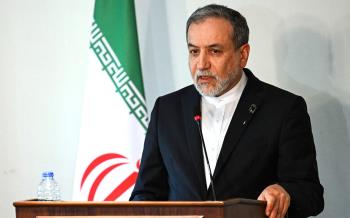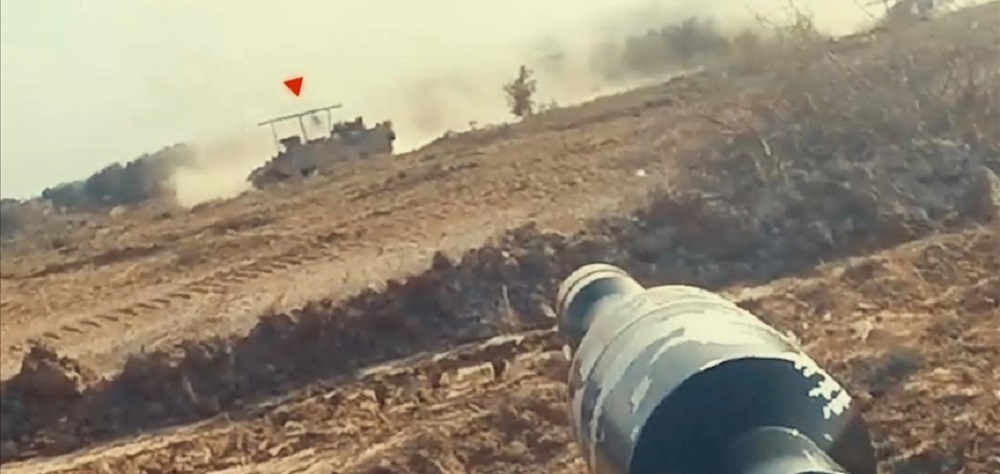Alwaght- It has been over two weeks since Israeli regime launched its ground offensive on Gaza, with war unfolding in various areas of the besieged enclave. During this time, the Israeli progress has been very slow and battleground surprises to the Israeli army have made the Israeli leaders talk about possibility of a long war just contrary to the first days of conflict.
In the videos published in recent days of the battlefield what has captivated the attention more than any other thing is the creative tactics of the Palestinian resistance forces that appear to the enemy’s heavy armored vehicles and tanks like a ghost, destroy them with shoulder-portable weapons, and then vanish into thin air.
Amid the heavy media censorship on the Israeli casualties and damages on the armored vehicles, the precise number of the destroyed heavy vehicles is unclear and the only source is the statements of the resistance groups that daily report the number of the successful destruction of tanks. On Saturday, Qassem Brigades, the military branch of Hamas, announced that its fighters successfully destroyed 25 Israeli armored vehicles within 48 hours.
In a recorded message, the prominent spokesman to Qassem Brigades, Abu Ubaida, reported that since the start of the ground offensive on October 27, the resistance fighters destroyed a total number of 160 Israeli tanks and armored vehicles.
“The battle between the Palestinian fighters and the Israeli army is unequal, but it still scares the Israeli army,” Abu Ubaida asserted, adding: “Our fighters come out of the ground and sky and from under the rubble to destroy armored vehicles and tanks.”
On the other side of the occupied territories in the north, Lebanese Hezbollah forces are also busy hunting out expensive Israeli tanks on a daily basis, and reports indicate that over the past two weeks, Israel has lost dozens of tanks of Merkava on its northern borders.
A video published by Hezbollah on Saturday showed two Israeli tanks moving to Shajar border region were destroyed by guided anti-tank missiles.
From Merkava to Barak: Advanced Israeli tanks on the battleground
Over the past 70 years, Tel Aviv has established methods and tactics of its fast war on the aircraft-tank dual.
In the first decades of its establishment, this regime worked out an effective military doctrine against the Arab armies. Meanwhile, the name of General Yisrael Tal came up. Tal was one of the Jews who volunteered in the British army and the Jewish Battalion in Italy during World War II before joining the notorious Haganah Zionist terrorist organization in 1946 and then the Israeli occupation army after 1948. Tal realized from his experience in the battles that tanks would play a pivotal role in the battles with the Arab armies, and his vision was indeed realized in the 1967 war, in which tanks played a crucial role and led to the worst Arab military defeat in the 20th century.
At the end of the 1970s, the Merkava tank was born from Tal’s plans and was commissioned in 1979. After the successes of this tank in the war of military occupation of Lebanon in June 1982, which was won against the Syrian army, which was equipped with Soviet T-72 tanks, Merkava became the jewel of Israeli army, from which new generations were constantly produced. Since then, Merkava was promoted by the Israeli media outlets and military and political officials as the enabler of ground battle superiority and an invincible weapon.
The most advanced versions of Merkava are fourth and fifth generations. The older generations lack the third and fourth-generation engines that are developed to ensure higher agility of the tanks and increase their strength from 900 horsepower to 1200.
According to the Military Factory website, the Merkava 4 has a 120 mm main gun and a 12.7 mm machine gun, stronger steel armor than previous versions and an advanced digital fire management system.
According to this outlet, Merkava 4.0 falls in the category of heavy tanks, its weight is up to 66 tons with crew and equipment, its speed is 46 kilometers per hour, its range is 400 kilometers, its length is 8.6 meters, its width is 3.7 meters, and its height is approximately 2.7 meters.
The fifth generation and most advanced version of Merkava tanks is called Barak. Barak sports electronic systems developed by several Israeli defense companies, including Albit Systems, Rafael, Israel Aerospace Industries subsidiary Elta, and others.
Here is a list of its advanced equipment:
1. Advanced sensors to identify targets and share intelligence between tanks and other army units
2. The tank operator’s helmet, produced by the Israeli company Elbit Systems, has a high technology known as IronVision that uses AI and is capable of 360° scanning.
3. Binoculars and improved night vision cameras
4. Its advanced user interface has the ability to process images with the help of AI.
5. Sporting advanced missile defense system known as Trophy.
6. Enhanced fire power
Collapse of Merkava legend
Despite the fact that military experts always categorize this tank among the world’s top tanks, its failure in dealing with the resistance groups over the past three weeks has proven the opposite of the Israeli claims.
In February 2002, after Palestinian resistance forces attacked Israeli settlers, Tel Aviv sent a Merkava to counter them, which was destroyed by an explosive trap laid by the Palestinian forces. This explosive trap separated the turret from the hull and killed three Israeli soldiers. Israeli analysts at the time described this attack as a devastating blow to the dignity of the Israeli army.
But this was just the beginning and the main blow was dealt to the legendary Israeli tanks in 2006 during the 33-day war of Israel against Lebanese resistance movement of Hezbollah. In this war, the Israeli army lost dozens of its tanks. At the time, the Russian-made Kornet missile, which seemed to have been provided to Hezbollah by Syria, became Israeli tanks killer. This advanced Russian missile with a range of 5 kilometers can penetrate armor more than one meter thick. According to data, during the 33-day war, out of 400 Merkava tanks that were present in the battlefield, 48 tanks were destroyed, 40 others were seriously damaged, and 20 more were penetrated by missiles.
After the 33-day war, the Israeli army sought to solve this problem by adding new equipment to its tanks to deal with anti-tank missiles. In 2021, the American magazine, National Interest, wrote in a report that the Israeli tank was equipped with ‘reactive armor’, a protection whose shockwave can prevent the lance of plasma from reaching the body of the tank.
But this technology does not seen to have worked for the Israeli tanks. The clashes that started between the resistance and the occupation army since October 16 show that Merkava like in 2006 is apparently vulnerable to the resistance’s missiles, mines, and drones, and the equipment it uses does not seem to provide the targeted performance.
During the current war, Qassam Brigades have provided their fighters with instructions to target Israeli tanks mainly focusing on the Trophy systems installed on these tanks. Trophy Active Protection Systems (TAPS) is a group of small radars and missile launchers that automatically identify and intercept any rocket oncoming to the tank. However, the tactics of Hamas fighters show that launching a rocket from a very short distance neutralize this protection system.
Hamas’s Al-Yassin 105 anti-tank rocket, the Merkava killer
Just unlike in the 33-day war, the weapon Hamas is using to strike the new-gen Israeli tanks is a home-developed one. The shoulder-fired Al-Yassin 105 are hand-made anti-tank rockets developed by Qassem Brigades in secret workshops in Gaza. This high-efficiency weapon was unveiled this year for the first time and used in October 7 Operation Al-Aqsa Storm against the Israeli occupation. This rocket is an enhanced version of the Russian Tandem rockets.
Al-Yassin rocket with their high-destruction power can penetrate the steel armor 60 cm after forcing its way into the outer protective layer. Its effective range is 100 meters and useful range is 150 meters. While each Merkava costs $7 million, Al-Yassin 105 rockets do not cost much, and the published images of the modest warehouses and military workshops of the Gaza resistance show its mass production.
This rocket is made of two-part warhead, a main and a secondary one that is also called back warhead, and is designed to penetrate the inner layer of the armor.
The first warhead consists of a high-explosive material that breaks through the tank’s outer armor, which is intended to protect it from anti-tank weapons.
The secondary warhead also consists of a high-explosive material that penetrates the tank’s hard armor and destroys it, killing the crew on board.
Here are the most obvious specifications of Al-Yassin rocket:
Shell caliber: 105/64 mm
Net weight: 4.5 kg
Effective range: 100 meters
Useful range: 150 meters
Speed: is 300 m/s
Capability: Penetration into armored steel and iron
What are anti-tank Tandem rockets?
Tandem that is used, though in a limited way, on the battleground by the resistance fighters is an anti-armor rocket developed by the Soviet Union in the 1970s and was commissioned in 1989 by the Russian army. This weapon is the parent of Al-Yassin 105, which was developed by reverse engineering. Tandem also sports a dual warhead.
The caliber of the Tandem is 105 mm and its weight is 6.1 kilograms. Its effective range is 500 meters and its maximum range is 800 meters.
Over two weeks after start of the ground offensive, the massive destruction of tanks has forced the Israeli commanders to, reportedly, order a retreat of tanks.
Undoubtedly, the destruction of the ostensibly modern Israeli tanks and their incapability to force their way into Gaza’s depth question the credibility of the stated features of Merkava and may lead to a drop in demands for this weapon as customers lose their faith in them.



























